�
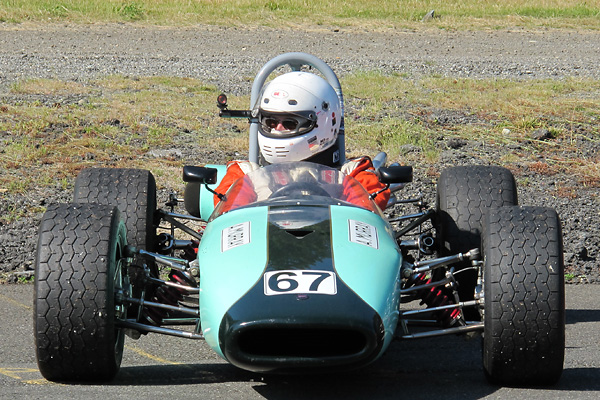
�
Al Murray's Lotus Twin-Cam Powered Brabham BT21 Racecar
� ��
Owner: Al Murray
�
City: Monroe, Washington
�
Model: Brabham BT21
�
Engine: Lotus Twin-Cam
�
Prepared by: owner�
�
Formation of Motor Racing Developments Ltd.
� �
Motor Racing Developments Ltd. was founded as a 50/50 partnership between Jack Brabham�
and Ron Tauranac. The two men had met years before, in 1951. Already by that time, Jack Brabham�
had won an Australian national championship in midget racecars and opened his own light engineering�
business. Ron Tauranac was building and racing cars too. Ron and his brother Austin Lewis�
amalgamated their initials into the name "Ralt" and begun applying that name to a series of cars�
of Ron's design, mostly powered by motorcycle engines. �
�
In early 1955, Jack Brabham left Australia for England where he hoped to shift his racing�
career into high gear. Shortly after arrival, Brabham met and struck a close friendship with�
John Cooper; the two gentlemen had much in common and compatable goals. Over the next few�
years, driving for the Cooper works racing team, Brabham's success depended in part on pitching-in�
and helping the Coopers refine their cars. Meanwhile, Brabham stayed in touch with Tauranac as a�
source of valuable and confidential technical advice. �
�
Driving a Cooper, Jack Brabham clinched his first Formula One World Championship at the last�
race of the 1959 season. By that time, he had already set up his own garage: Jack Brabham Motors�
in Chessington. The championship secured Brabham's financial situation, and he was finally able�
to make an impossible-to-refuse offer to his old friend. In early 1960, Jack Brabham convinced�
Ron Tauranac to come race in England. There were some odd jobs to provide cover, including�
swapping Climax engines into late-model Triumph Herald street cars, but within weeks Ron Tauranac�
was secretly at work designing the first Motor Racing Developments race car. It had to be kept�
secret because Jack Brabham was still driving for Cooper. In fact, he won a second Formula One�
world championship for Cooper in 1960. He would ultimately win the championship a third time,�
but in a Brabham instead of a Cooper!�
�
When their first car was ready to unveil, Jack Brabham announced it from a monthly column he�
wrote for Motor Racing magazine. Brabham initially referred to that car as "the MRD". For�
marketing reasons, Motor Racing Developments soon began applying the tradename "Brabham" to�
its products. Once there was a need to differentiate multiple models, MRD assigned�
numeric designations, all prefaced "BT" (for Brabham and Tauranac respectively.)�
�
The first car, retrospectively known as the BT1, was a Formula Junior. From 1961 through 1963�
Formula Junior was really the closest thing to Formula One. Formula Two and Formula Three had�
been temporarily discontinued, and in their place Formula Junior races were internationally�
sanctioned by the FIA. The really big difference between Formula One and Formula Junior was�
driveline cost: compare a mass-produced, 1.1 liter, pushrod four-cylinder engine versus a�
strictly-for-racing, 1.5 liter, overhead-cam V8. �
�
In 1962 MRD constructed eleven Formula Junior cars for outside customers alongside their�
first Formula One car for Jack Brabham's use. These were the BT2 and BT3 models, respectively.�
With the BT3, Jack Brabham became the first driver to score Formula One World Championship�
points in a car bearing his own name and also the first driver to win a Formula One race at�
the wheel of an eponymously named racecar. He did so at the 1963 Solitude Grand Prix (near�
Stuttgart) and again five weeks later at the Austrian Grand Prix, except with a five lap�
margin of victory! (Both races were non-championship Formula One events.)�
�
Far greater success would come soon. In 1966 Jack Brabham piloted a BT19 to four consecutive�
championship series victories to earn the Formula One World Championship. Brabhams dominated�
the constructors championship even more convincingly in 1967 when Denny Hulme and Jack Brabham�
upgraded to the new BT24 model and scored a one-two finish in the championship series points race.�
�
MRD would ultimately build almost six hundred single-seat racecars, but they built remarkably�
few sports cars. Two Lotus twin-cam powered sports racers were built in 1963, designated BT5.�
Body styling from the BT5 was largely carried over to the BT8A of 1964 through 1966. Twelve�
were built, with a variety of engines including a 2-liter BRM V8, then 2.0, 2.5,�
and 2.7L 4-cylinder Climax mills. At least one BT8A was re-powered with an Oldsmobile "215"�
aluminum V8. Finally, a stretched variant of the BT8A (named BT17) was built in 1966. Fitted�
with wide tires, big brakes, and a Repco-enhanced Oldsmobile engine as used in the BT19�
Formula One car, the Brabham BT17 was intended for Group 7. Jack Brabham drove it in exactly�
one race, and MRD never built another sports racer.�
�
Interestingly, with few exceptions MRD relied on outside help for fabricating frames and bodies.�
A kit-car builder named Buckler built the very first frame to Ron Tauranac's drawings, and a�
one-off aluminum body was sourced from a local shop. From the BT2 on, frames were sourced from�
Progress Chassis Company which had originally been founded by friends of Colin Chapman specifically�
to build frames for the Lotus Mk6 model. Progress Chassis provided frames through BT16A production�
(circa 1965). From the BT17 model (circa 1966) until the monocoque era, MRD sourced frames from�
Arch Motors. (MRD's first monocoque car was the BT33 Formula One car of 1970, and their first�
monocoque chassis for an outside customer was the BT38 of 1972.) From the BT2 on, fiberglass bodies�
were made by Specialized Mouldings. With these two key components outsourced, Tauranac could�
focus keenly on maintaining the exceptional design integrity and meticulous craftsmanship�
that Brabham racecars have always been known for.�
�
�
 �
�
�
�
Brabham BT21: MRD's Classic Formula Three Model (circa 1966-1968)
��
While Jack Brabham primarily focused on running a racing organization, Ron Tauranac was�
focused on designing and constructing racecars for the Junior Formulae. It was a tough�
business, but Tauranac thrived in it. Motor Racing Developments was clearly the preeminent�
constructor of cars for Formula Two's 1.6L era. They were also a leader in one liter�
Formula Three cars, both in terms of sales and race victories. This success was mirrored�
in the Sports Car Club of America's Formula B and Formula C classes.�
�
Introduced in 1966, the Brabham BT21 was nominally a Formula Three model developed from the�
earlier BT18. Virtually all BT21s were powered by Ford-based engines and featured Hewland Mk6�
gearboxes. Compared to the BT18, the BT21's spaceframe was "shallower" but noticeably stiffer.�
The design's track dimension was wider while the body was slimmer.¹�
Although the BT21 model arrived late in 1966, it was destined to become Brabham's best�
selling model. Fifty original BT21 Formula Three cars were built, plus four later variants�
that brought total BT21 production to 110 cars: �
(a) BT21A - Formula Libre variant with Lotus-Ford Twin Cam - ten built in 1967,�
(b) BT21B - a BT21 with 13x7 front and 13x9 rear wheels and heavier duty Hewland FT200 gearbox - 31 built between 1967 and 68,�
(c) BT21C - a Formula Libre version of the BT21B - 18 built, and�
(d) BT21X - a works/development car with stiffer spaceframe - 1 built.�
�
Al Murray's Car (Arch Motors frame #177)
��
As originally constructed, Al Murray's very early BT21 would almost certainly have been fitted with�
a one liter Cosworth "Modified Anglia Series E" (MAE) Ford four cylinder engine for use in Formula Three.�
By class rules it would have been fitted with a single inlet restriction and a Weber IDA downdraught�
carburetor. Despite the restrictions, these engines were remarkably powerful! They produced about 100bhp�
at 9500rpm. The very high engine speed of Formula Three cars in this era earned them the popular name�
"Screamers". �
�
This particular car was owned by Marc Bahner at the end of the 1960s, until he sold it to Tom Shanley�
of Riverside. Tom explained (in December 2007): "This is my old car from the early seventies. I aquired�
it from Marc Bahner. I raced it with a Cossie SCC, an 1100cc MAE downdraught, a twin-cam, and a BDA at�
different times. Raced as a Formula Continental a lot of the time and as a Formula B too. I sold the car to�
Brad Schiere of Burbank in the early/mid 1980s. At that time it was in pieces as we (at British Sports�
and Exotics in Riverside California) had just rejigged the chassis and installed a taller rollbar, as we�
were going to update the chassis with a Lucas fuel-injected BDA. The car was sold to Brad with Hewland�
Mk5 and about 30 gear changes. I also included four or five sets of MRD wheels: 6/8/10 fronts and�
8/10/12/14 rears. Not installed were a set of BT23 front upper control arm pieces I got from Pete Halsmer.�
As I understand it, Brad sold the car to Sperry Valve works a few years later."�
�
From then it sat in storage for about twenty years until December 2005 when Dan Longacre of Dana Point�
California (just south of Los Angeles) sold it to Al. When puchased, the BT23-style front upper�
link/trailing arm conversion had been installed, but Al has subsequently restored the car to BT21-style�
control arms. Only one set of original MRD wobbly wheels (8" front and 9"rear) came with the car.�
Formula 3 spec Girling AR brakes were installed all around. Everything else about the chassis was�
"basic BT21". No motor or gearbox was included with the sale, but Al already had a suitable Lotus�
twin-cam and a Hewland Mk8 transaxle. He later retrofitted a Hewland Mk6. In restoring the car, Al�
noted that all the body panels seemed to have a matching sequence of thirteen paint layers, which�
suggests that the bodywork has been intact for most if not all of the car's career.�
�
Please support the sponsoring companies who make www.BritishRaceCar.com possible, including:
� �
 �
�
�
�
Features and Specifications
�| Engine: | �Lotus-Ford twin-cam engine.�
Dual Weber 45DCOE carburetors.�
Pipercross foam air cleaner.�
Lucas distributor.�
Pertronix Ignitor ignition module.�
(No electronic rev limiter.)�
Lucas Sport (gold) ignition coil.�
Taylor Pro 8mm silicone spark plug wires.�
Dry sump lubrication system.�
| �
| Cooling: | �crossflow copper/brass radiator with integral oil cooler. | �
| Exhaust: | �vintage sand-bent 4-into-1 header. | �
| Transaxle: | �Hewland (Mk6 case and bearing carrier. Mk5 gears.)�
Rotoflex drive couplings.�
Girling master cylinder (5/8" bore).�
Girling slave cylinder. | �
| Front Susp.: | �unequal length wishbones.�
Alford & Alder (Triumph Herald pattern) forged uprights.�
KONI shock absorbers.�
Eibach springs (350 pound/inch).�
Adjustable 9/16" anti-sway bar.�
Brabham proprietary steering rack. | �
| Rear Susp.: | �inverted lower wishbones, single top links, and twin radius arms.�
Brabham proprietary magnesium uprights.�
KONI shock absorbers.�
Eibach springs (300 pound/inch).�
Adjustable anti-sway bar. | �
| Brakes: | �(master) dual Girling master cylinders (3/4" bore front, 0.7" bore rear) with adjustable bias bar. � (front) Girling AR brake calipers with solid rotors, � (rear) Girling brake calipers with solid rotors. | �
| Wheels/Tires: | �MRD wobbly web style magnesium wheels (13x8 front, 13x9 rear.) �
Avon tires (8.2/22.0-13 front, 10.5/23.0-13 rear.) | �
| Electrical: | �Interstate Cycle-Tron (AGM) battery. | �
| Instruments: | �(left to right)�
Smiths dual oil pressure (0-100psi) and water temperature (90-230F),�
Smiths Chronometric cable driven tachometer (500-9000rpm), and�
Smiths oil temperature (40-140C) guages. | �
| Fuel System: | �Fuel Safe wedge-shaped aluminum under-seat fuel cell.�
| �
| Safety Eqmt: | �Simpson cam-lok six-point safety harness.�
FireBottle duPont FE-36 filled centralized fire supression system.�
Mountney steering wheel with quick release hub.�
| �
| Racing Class: | �currently configured for vintage Formula B. �
| �
Engine Installation
��
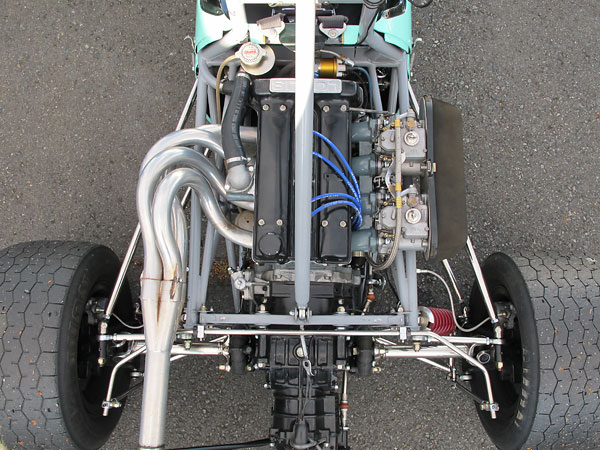
�
Lotus-Ford twin-cam engine. This car has had at least five different engines in its racing career.
�
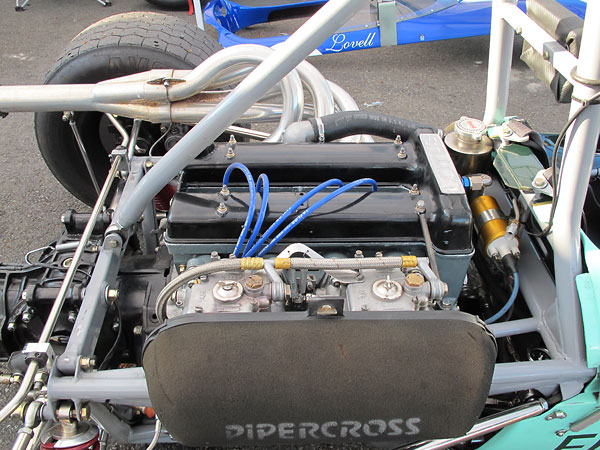
�
With this engine installed the car is suitable for North American "Formula B" racing.
�
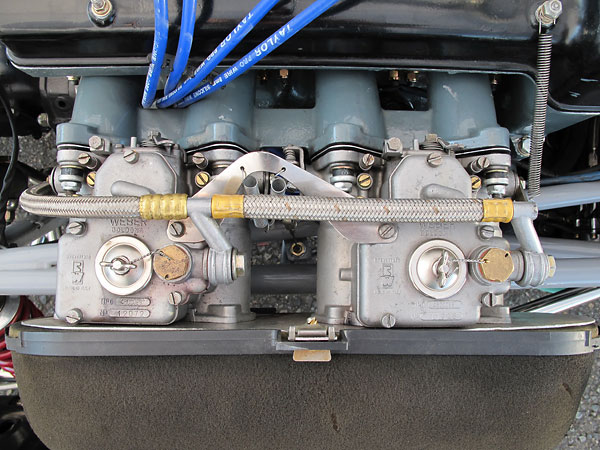
�
Pipercross foam air cleaner.
�
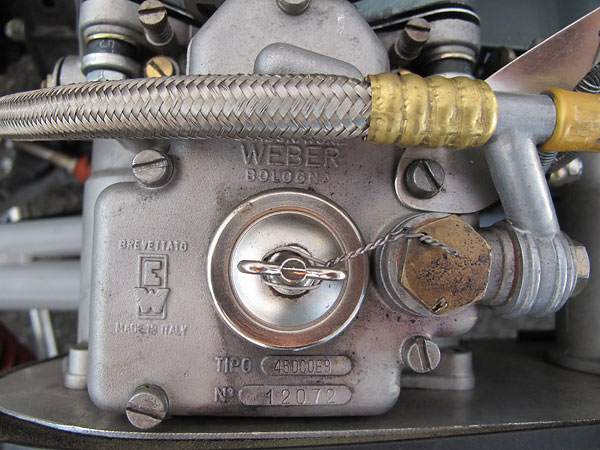
�
Weber carburetor: type 45DCOE9, number 12072.
�
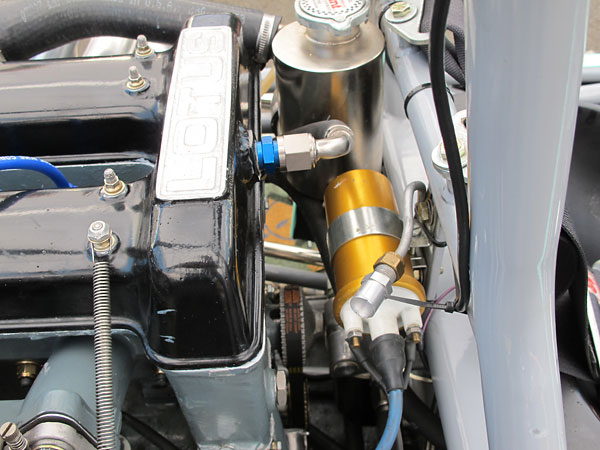
�
Lucas Sport ignition coil.
�
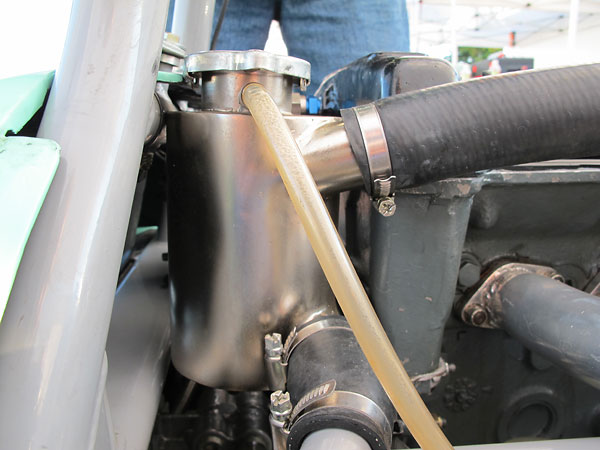
�
Beautifully crafted steel coolant swirl tank. (Swirling action promotes removal of steam bubbles.)
�
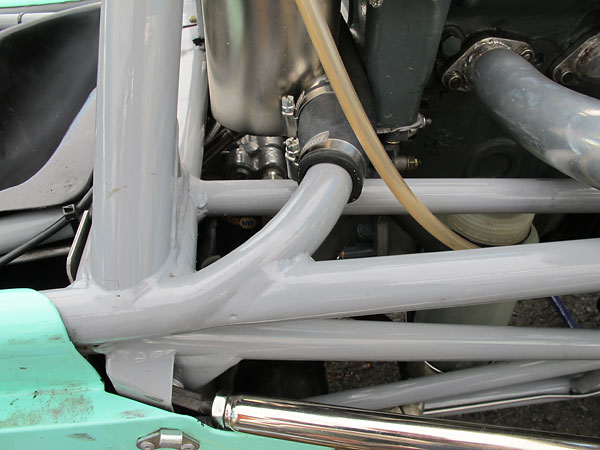
�
Through the frame coolant plumbing.
�
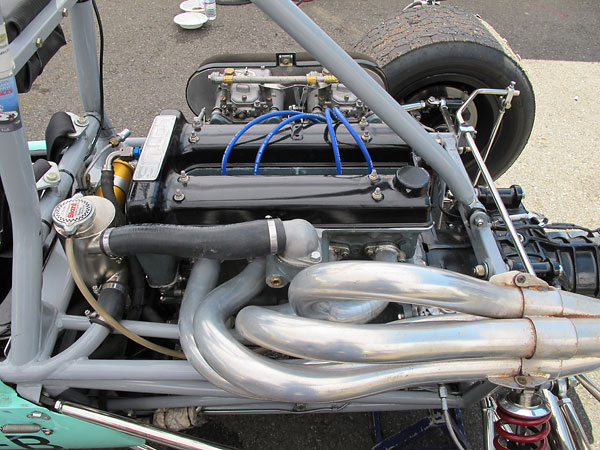
�
Custom 4-into-1 exhaust header. Three different headers were available on BT21 F3 car
�
from the factory: a 4-into-2-into-1, a 4-into-1, and an "up and over". All three were
�
specifically crafted for a Ford MAE engine mounted at 30 degrees from upright.
�
�
IMPORTANT ANNOUNCEMENT
�
BritishRaceCar.com will have to cut back plans for continued growth if we can't find more financial support.
�
If you like what you've found here, and you want to see more, please click here and follow the instructions.
�
Readers like you keep BritishRaceCar.com online and growing through voluntary financial contributions.
�
Front Suspension / Etc.
��
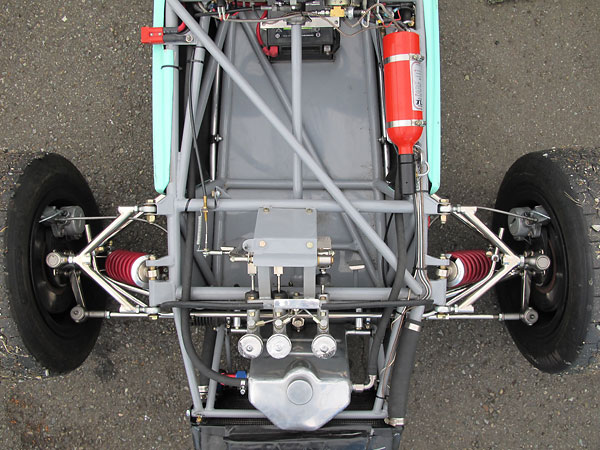
�
In this view the front suspension appears quite conventional. Two changes since 1966: tires
�
and spring rates. The most obvious tire difference is generally lower aspect ratios.
�
Partly as a reaction to that, today's vintage racers (including Al) typically select
�
springs with up to twice the rates that the constructors originally supplied.
�
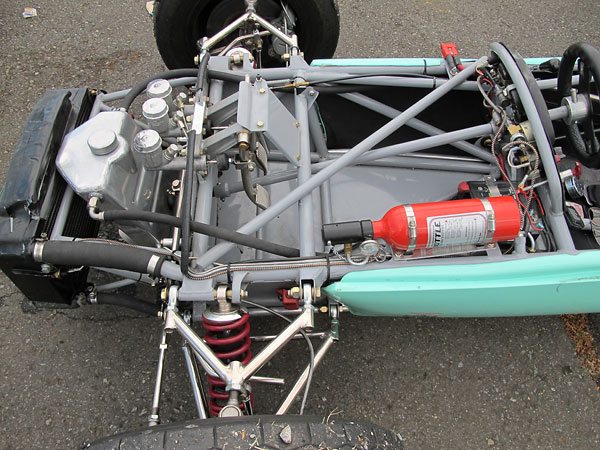
�
The pedals are mounted on robust brackets. Note the deep cross-section of the bracket castings.
�
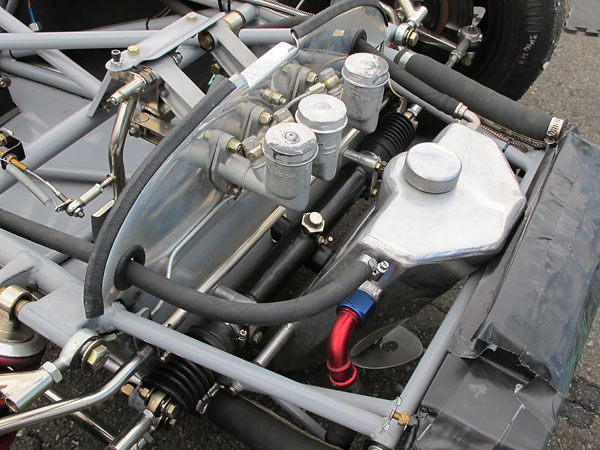
�
When Ron Tauranac needed a rack and pinion steering box made for the Brabham BT1, he went to
�
Jack Knight Engineering and showed them exactly how he wanted it made. He even turned over
�
to Knight a pattern for the housing he'd previously used on Ralt racecars back in Australia.
�
From that time on, Jack Knight provided the custom steering racks used on Brabham racecars.
�
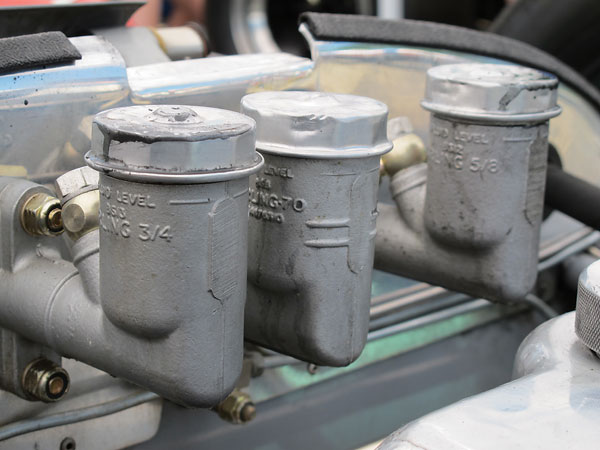
�
These Girling master cylinders are labeled with their bore diameters: 3/4", 0.7" and 5/8".
�
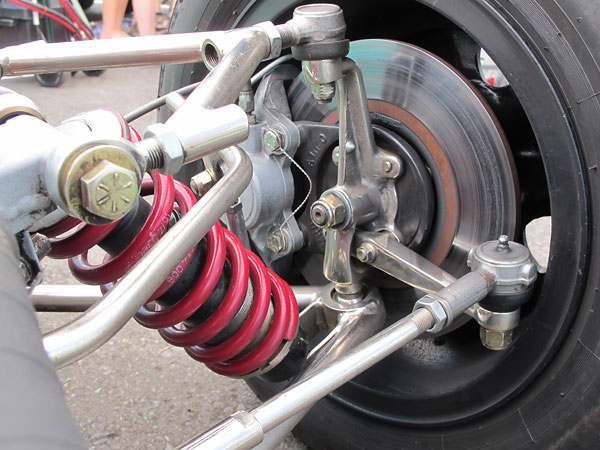
�
Alford & Alder (Triumph Herald pattern) forged uprights. Note well that MRD machined the bottom
�
of the upright so they could mate it to a spherical bearing in the wishbone, whereas some other
�
constructors used a Triumph trunnion. The spherical bearing facilitates castor adjustment and
�
ultimately makes it easier to dial in some anti-dive. MRD supplied the forged steel steering
�
arms (as shown here) which were shorter than those available from the Triumph parts bin. MRD
�
also provided this nifty custom bracket for mounting the Girling brake caliper to the upright.
�
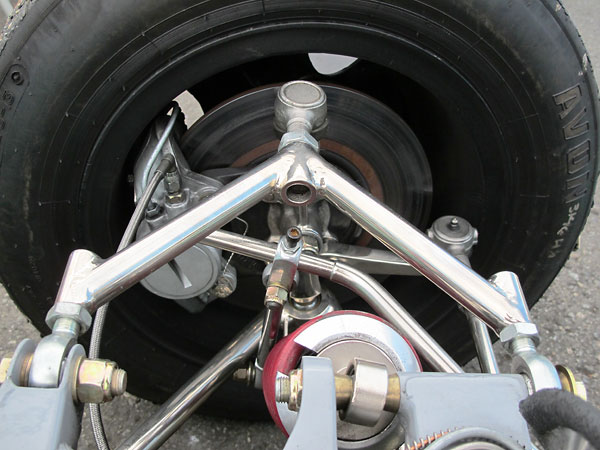
�
Some drivers complained of vibration in the BT21 front suspension under hard braking, so on
�
the BT23 model the upper front control arms were redesigned with a wider base. From about
�
1968, Wayne Mitchell offered a kit to convert BT21's to a similar "trailing link" design.
�
Fitting the kit required welding bosses onto the frame back near the instrument panel.
�
Al's BT21 was converted before he purchased it, but he has reverted back to original.
�
�
�
Rear Suspension
��
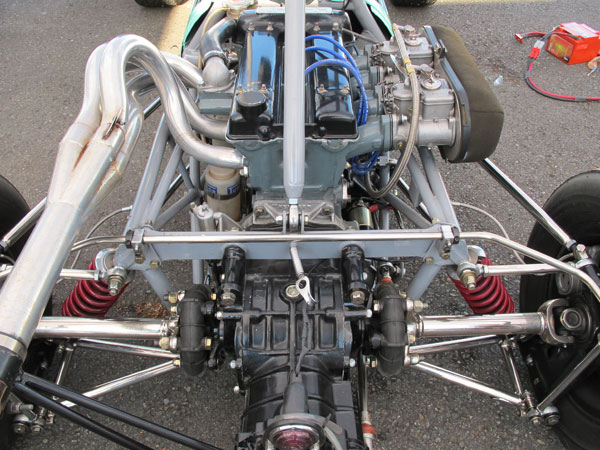
�
Independent rear suspension featuring inverted lower wishbones, single top links, and twin radius arms.
�
Too small to see: this frame is stamped "AM 177". Starting with the BT17 model of 1966, Arch Motors
�
produced Brabham frames under contract. Arch's serial numbers (e.g. "177") don't have any particular
�
meaning but they can be helpful in identifying specific cars. Frames for most earlier Brabham cars,
�
through the BT16A of 1965, were produced by the Progress Chassis Company.
�
�
Interior
��
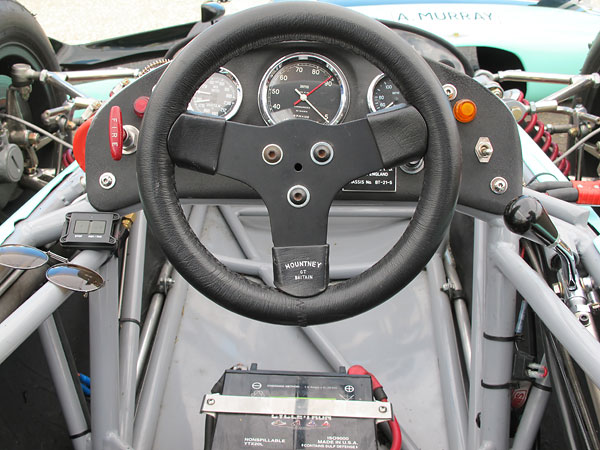
�
"Mountney GT Britain" steering wheel.
�
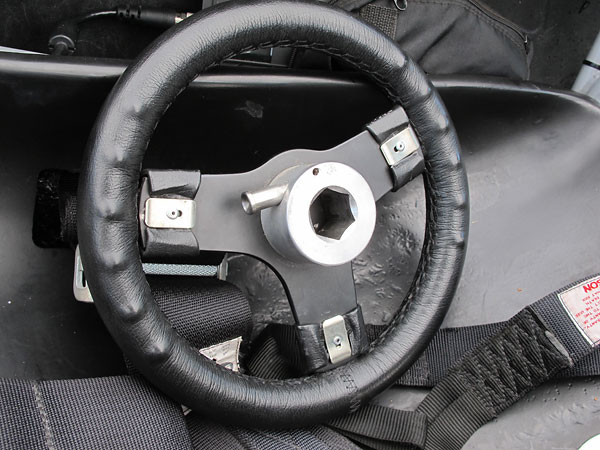
�
Quick release steering wheel hub.
�
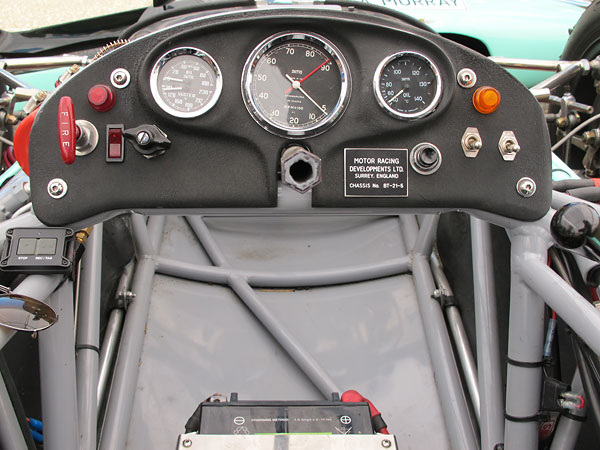
�
(left to right) Smiths dual oil pressure (0-100psi) and water temperature (90-230F) gauge,
�
Smiths Chronometric cable driven tachometer (500-9000rpm), and Smiths oil temperature (40-140C) guage.
�
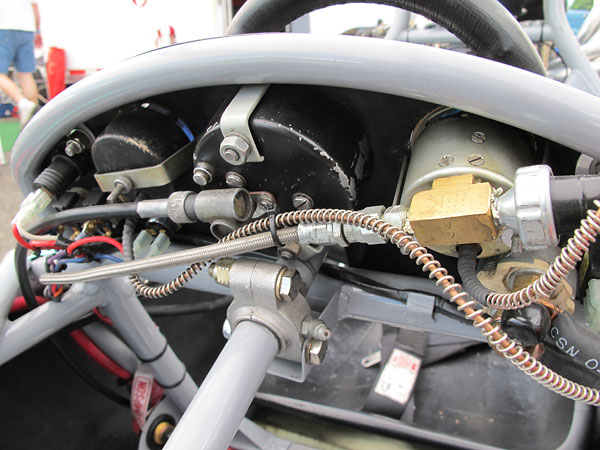
�
Steering column and dashboard details.
�
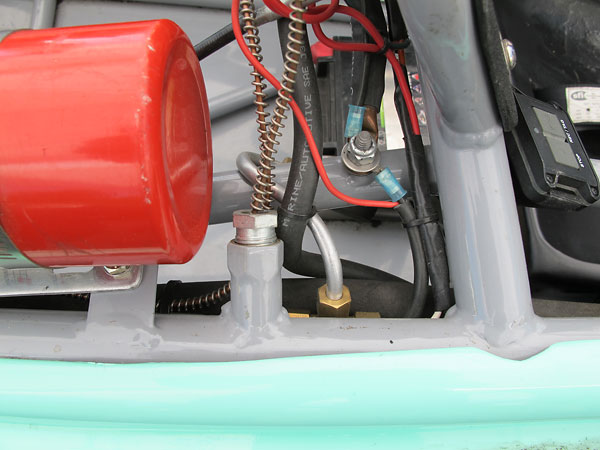
�
Engine coolant is plumbed through frame tubes, so it's extremely convenient to put
�
the coolant temperature sensor physically close to the gauge.
�
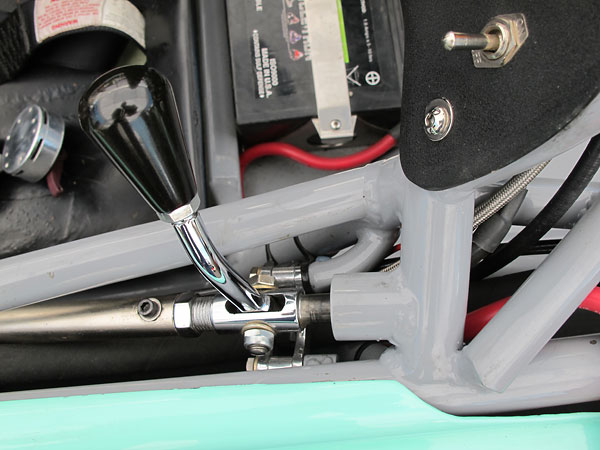
�
Gear selector mechanism.
�
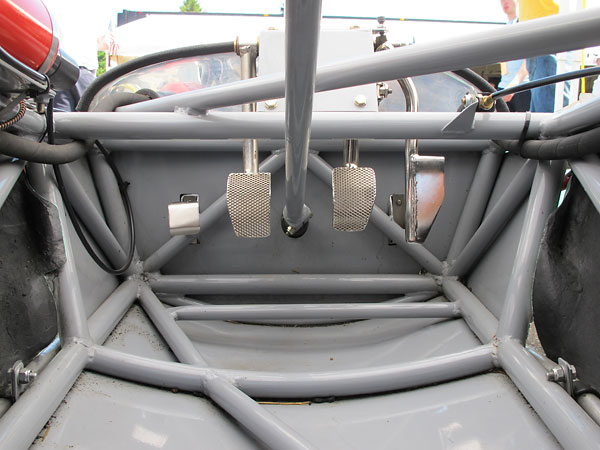
�
Welded-in steel floorpan: a partial pan was originally installed but Al prefers a full length pan.
�
Two driver-friendly features - a dead pedal for the left foot and good stout heel bar - but they're
�
different from how the car was originally delivered! Brabham didn't supply a dead pedal, probably
�
because car owners could so easily make and adjust one to their own preference. Brabham did
�
supply the BT21 with a heel bar, but the original one was a cast part which bolted into place.
�
�
�
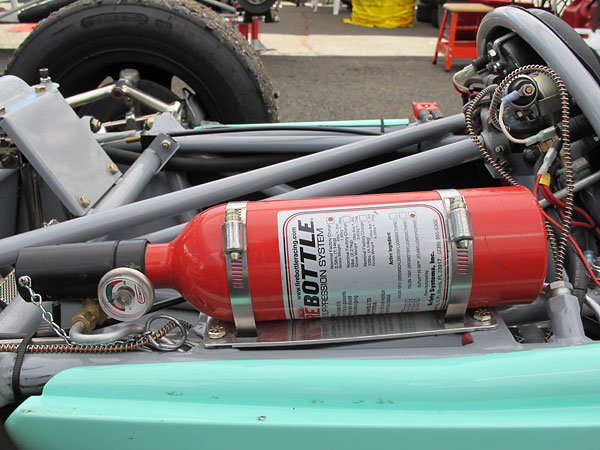
�
FireBottle duPont FE-36 filled centralized fire supression system.
�
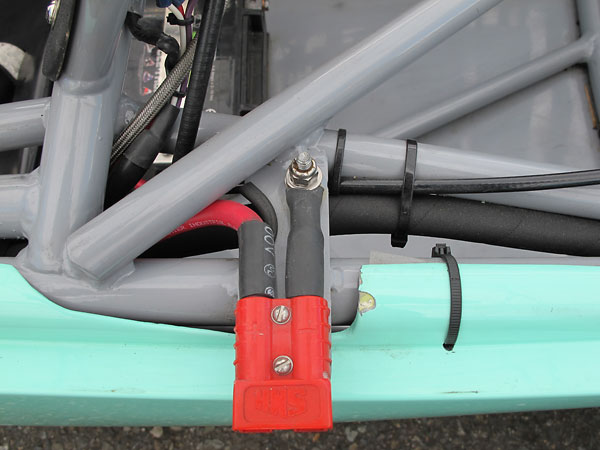
�
HMS jump start connector.
�
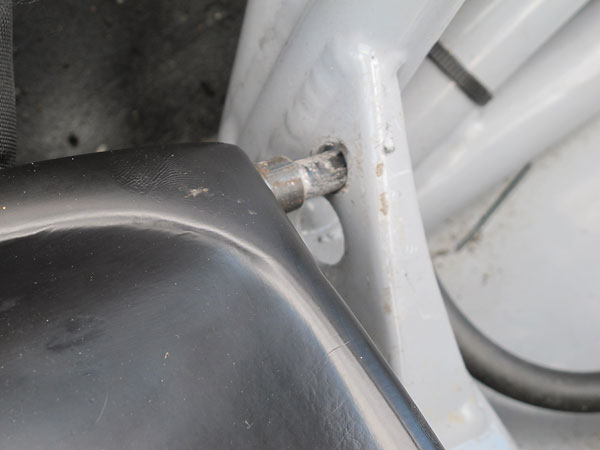
�
Two nibs on the front of the fiberglass seat plug into brackets on the frame. There are bolted
�
connections at the engine bulkhead too. (See the fuel-cell photo below.)
�
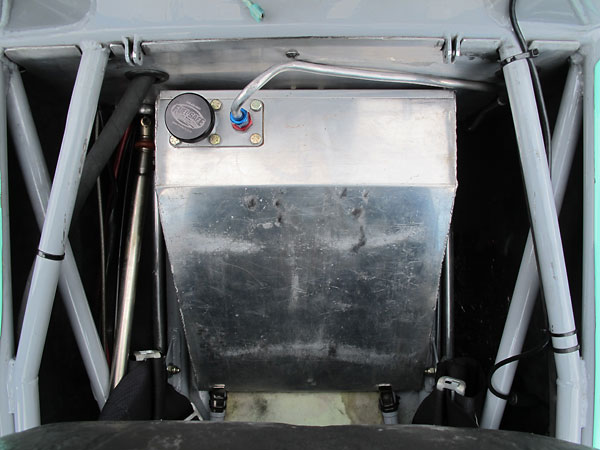
�
Fuel Safe wedge shaped aluminum under-seat fuel cell.
�
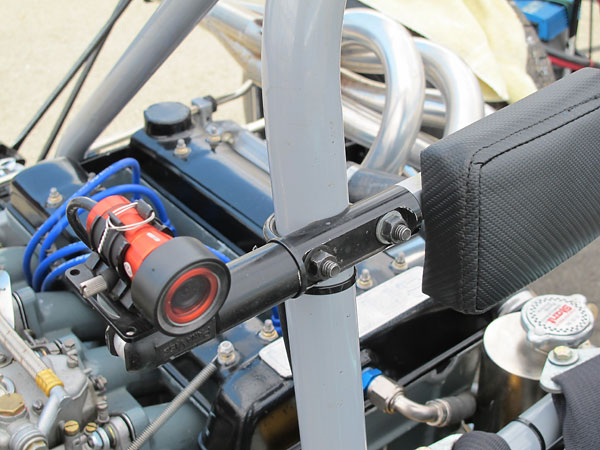
�
Left: camera. Right: roll hoop height has been raised to meet modern safety requirements.
�
| Notes: | ||
| (1) | �
Compared to the earlier BT15 Formula Three car and the BT14 Formula Libre and�
BT16 Formula Two cars that shared its frame, both the BT18 and BT21 are longer�
in the engine bay area and also feature taller uprights which helped their�
suspensions better accommodate a new generation of wider tires. All of these�
models bear striking similarities. Like the BT21, the BT15 was a particularly�
successful model in all respects. 58 BT15s were built, and with them 42 major�
Formula Three races were won in period.�
� | |
�
Unless otherwise noted, all photos shown here are from June 2011 when we viewed this car�
at The Pacific Northwest Historics at Pacific Raceways in Kent, Washington.�
All photos by Curtis Jacobson for BritishRaceCar.com, copyright 2011.�
All rights reserved.
�
| If you liked this article, you'll probably also enjoy these: | �|||||
 | �
Bill Bovenizer '68 Titan MkIII | �
 | �
Brad Baker '69 Brabham BT30 | �
 | �
Jim Johnson '72 March 729 | �
�
| You're invited to discuss anything you've seen here on The British Racecar Motorsports Forum! | �|||||
�
Notice: all the articles and almost all the photos on BritishRacecar.com are by Curtis Jacobson.
�
(Photos that aren't by Curtis are explicitly credited.) Reproduction without prior written permission is prohibited.
�
Contact us to purchase images or reproduction permission. Higher resolution images are optionally available.
�

 �
�